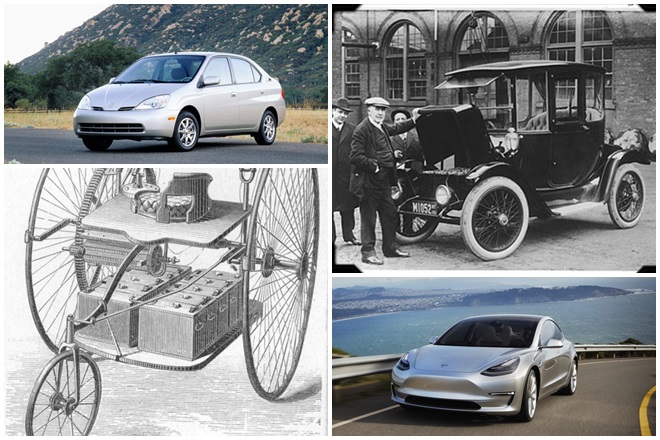Do You Know the History and Future of Electric Vehicles
#ElectricVehicle, #EVHistory, #TeslaRevolution, #GreenMobility, #CleanEnergy, #ZeroEmission, #ElectricCars, #FutureOfTransport, #SustainableMobility, #EVIndia, #ClimateAction, #LithiumBattery, #AutonomousEV, #ChargingStation, #SolarCar, #EVRevolution, #SmartCities, #VehicleToGrid, #ElectricVsGas, #AutomobileFuture
TECH & SCIENCE
7/26/20252 min read


Electric Vehicles (EVs) are revolutionizing how we think about transportation and energy. While many see them as a modern marvel, did you know that electric cars actually date back over a century? This article dives into the rich history, present-day boom, and future promise of EVs.
1. The Early History of Electric Vehicles
The first practical electric vehicles appeared in the late 1800s. In the 1880s and 1890s, inventors in Hungary, the Netherlands, and the U.S. were already testing battery-powered carriages.
By the early 1900s, electric cars were more popular than gasoline-powered cars in the U.S. due to their quiet operation, ease of use, and no manual gear shifting.
In 1900, 38% of all vehicles in the U.S. were electric, while steam and gasoline trailed behind.
In 1901, Thomas Edison began developing better EV batteries, and Henry Ford considered electric versions of the Model T.
2. The Decline of Early Electric Cars
The decline began in the 1920s due to several factors:
Mass production of gasoline cars made them cheaper.
Better road infrastructure encouraged longer travel, which EVs couldn’t handle with their limited range.
The discovery of abundant oil reserves made gas more affordable.
By 1935, electric vehicles had all but vanished from the roads.
3. The Revival Begins: 1970s to 1990s
The 1973 oil crisis reignited interest in alternative energy vehicles.
Automakers began experimenting with hybrid and electric prototypes.
In the 1990s, GM introduced the EV1, one of the first modern electric cars, but it was leased—not sold—and was later controversially discontinued.
4. The Tesla Revolution and Mainstream Adoption
In 2008, Tesla Motors launched the Roadster, a sleek, fast electric sports car with a 245-mile range—proving EVs could be both functional and exciting.
Tesla’s success influenced legacy carmakers like Nissan (Leaf), Chevrolet (Bolt), and BMW (i3) to launch their own EVs.
Governments across the world started offering incentives, subsidies, and tax breaks to boost EV adoption.
5. Current Scenario: A Rapidly Growing Industry
As of 2025, there are over 30 million EVs globally, with China, the U.S., and Europe leading the market.
Major brands like Mercedes, Toyota, Ford, and Hyundai are shifting towards all-electric lineups by 2030–2035.
EV infrastructure, such as charging stations, has expanded rapidly. India’s EV policy is also promoting faster adoption through subsidies under FAME II.
6. Technologies Powering EVs Today
Lithium-ion batteries dominate current EV tech—powerful, rechargeable, and efficient.
Development in solid-state batteries promises better safety and faster charging.
Innovations in regenerative braking, AI driving systems, and vehicle-to-grid (V2G) communication are shaping the smart future of EVs.
7. Environmental Benefits of EVs
EVs produce zero tailpipe emissions, drastically reducing air pollution in cities.
They help reduce carbon footprints, especially when powered by renewable energy.
Governments are promoting EVs as part of their net-zero carbon targets.
8. Challenges EVs Still Face
Range anxiety: Fear of running out of charge during long trips.
Charging infrastructure: Still under development in many regions.
Battery disposal and recycling: A growing concern for sustainability.
Initial cost: Though dropping, EVs are still more expensive than ICE vehicles.
9. The Future of Electric Vehicles
EV sales are expected to surpass gasoline cars by 2035 globally.
Battery costs are falling, making EVs more affordable.
Emerging innovations:
Wireless charging
Self-driving electric taxis
Solar-powered vehicles
Electric airplanes
EVs will play a critical role in the global fight against climate change.
Conclusion
The electric vehicle journey, from forgotten technology to a global solution, shows how innovation and environmental responsibility can merge to reshape our world. As we move toward a cleaner, smarter future, EVs are not just cars—they are symbols of change, sustainability, and progress.
Knowledge
Empowering minds with reliable educational content daily.
Newsletter Signup
© 2025 DoYouKnow. All rights reserved.
Stay Ahead of the Trends – Join Our Newsletter
